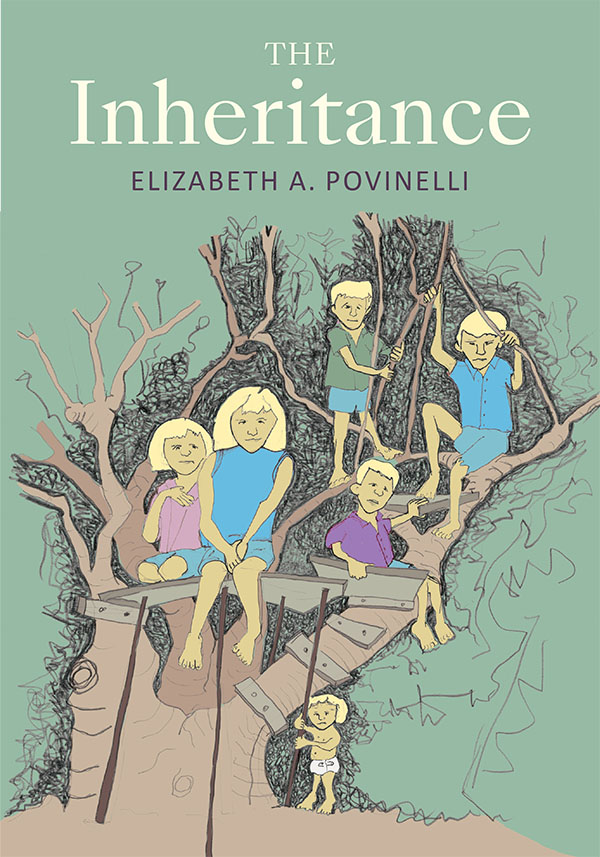
 Elizabeth Povinelli’s The Inheritance is a graphic memoir and visual meditation on familial, racial, social, and national belonging. What is it that we actually inherit from our forebearers? Is it blood, a sense of place, social identity? Povinelli situates family stories about place and blood told to her by her grandparents within the broader social narratives of European immigration to the US. The text, which unfolds in three acts, blends grayscale pencil, ink, and watercolor drawings by Povinelli with family photographs, maps, historical texts, and images. In conversation with the multilayered imagery is interpretive and explanatory text from the author. This book is memoir, art, and anthropology, as it cleverly addresses the interplay between individual lives and collective experiences, thus inviting a more open and associative mode of interpretation than most academic monographs. Through the case study of her own family, Povinelli argues for complicating the cohesiveness of European immigration stories and marshals the ambiguities of imagery to offer a critical anthropological statement about such stories’ relationship to social infrastructures of inequality.
Elizabeth Povinelli’s The Inheritance is a graphic memoir and visual meditation on familial, racial, social, and national belonging. What is it that we actually inherit from our forebearers? Is it blood, a sense of place, social identity? Povinelli situates family stories about place and blood told to her by her grandparents within the broader social narratives of European immigration to the US. The text, which unfolds in three acts, blends grayscale pencil, ink, and watercolor drawings by Povinelli with family photographs, maps, historical texts, and images. In conversation with the multilayered imagery is interpretive and explanatory text from the author. This book is memoir, art, and anthropology, as it cleverly addresses the interplay between individual lives and collective experiences, thus inviting a more open and associative mode of interpretation than most academic monographs. Through the case study of her own family, Povinelli argues for complicating the cohesiveness of European immigration stories and marshals the ambiguities of imagery to offer a critical anthropological statement about such stories’ relationship to social infrastructures of inequality.
In Act I, which centers on Povinelli as a girl growing up in Shreveport, Louisiana, we learn about the environment of her family. Against the backdrop of images of the Civil Rights struggle in the 1960s, the stuff of daily life—arguments, family meals, math lessons, casual violence, conversations—take place in the universe of the family home, the psychic center of which is a mysterious framed map on the wall. The map depicts the region of Trentino-Alto Adige, a borderland situated between Italy and the former Austrian-Hungarian empire where the Povinellis’ paternal village of Karezol (in historical local dialect) or Carisolo (in contemporary Italian) is located. The map occupies a powerful nexus in the family world, as it contains multiple narratives—even its name is different depending on which family member is speaking. Maps of the family house, of the neighborhood, and of Caddo Parish in Louisiana, once the land occupied by the Caddo Indians, juxtapose images of the family’s map creating a sense of the layering of place-based identities.
Act II expands on the legacy of the Karezol/Carisolo map through case studies of young Elizabeth’s ancestors to elucidate the complications, contestations, and omissions that riddle the European immigration stories featured in this book. By employing this focus, Povinelli demonstrates that beneath any romanticized version of her grandparents’ movement from Europe lie messy and unsettled realities. Act II begins with Papa Povinelli, an artisan knife-maker Povinelli, her siblings, and parents would visit in Buffalo, New York. For young Elizabeth, Papa’s stories of his journey from the place he calls Karezol to the US take on the mythic proportions of a founding ancestor’s struggle. Papa, born in the US and christened a non-traditional name before returning to Europe, tells a story about his birth, his naming, and his social legacy in relation to Karezol that more closely fits his emotional reality than the factual happenings. Papa’s story offers a window into the complexities of how immigration has affected him as a scorned and later displaced son of the village, and as a domineering patriarch, the legacies of which deeply impact the rest of the family. Act II also explores the personal stories of Povinelli’s mother’s father, who immigrated from another historically contested European borderland, Alsace-Lorraine, and of her father’s mother, Papa’s wife, Gramma. Through Gramma we learn more of the place she knows as Carisolo and feel the acute grief and loss that can come from fleeing a war-torn homeland. Povinelli draws images of WWI soldiers in gas masks from Gramma’s experience adjacent to the hooded KKK figures seen by young Elizabeth in Shreveport to demonstrate how layered emotional valences comprise a family’s experience of identity and belonging. Further, such complicated experiences are situated within broader social contexts that themselves are contested.
Act III addresses the racial landscape of the US directly and how Povinelli’s family, descended from European immigrants, was situated within it. In Act III we see 1960s and 1970s Louisiana: segregation, redlining, the removal of Black families from gentrifying white neighborhoods, children playing in clouds of DDT, Black Power, and Red Power movements. Her dad’s failure to be elected to local office highlights prejudice against Catholics—a theme paralleled in the scenes at school that call attention to how the family’s Italian heritage is perceived as “ethnic” in relation to other families who had long been subsumed into the category of “white.” A tree house where the Povinelli children play, which is featured on the book’s cover, is plowed down during the white neighborhood’s expansion into poorer, Black neighborhoods, suggesting a metaphorical significance as the unique “family tree” gives way to their family’s incorporation in the generic white suburb. This chapter explores how land creates a sense of located belonging but also zooms out to consider the dislocations piled upon dislocations in a racialized settler society.
Through multiple modes of inquiry—memoir, anthropology, and art—Povinelli queries the ways in which a family’s immigration stories intersect with the inequities of US society. As readers, we embark on this journey with young Elizabeth as her consciousness of this intersection grows. Povinelli, as a memoirist, depicts the ambiguities of a child’s awareness in an adult world well. As an anthropologist, she utilizes this developing awareness as a vehicle for social analysis. As an artist, she creates scenes in which text and image work together on multiple registers. In one such scene, the family goes on a vacation road trip and our narrator points out how the infrastructure was made for whites’ mobility. The glass of the car window has a bullet hole in it, and the glass fractures outward from the hole. Behind the glass is young Elizabeth, but after she leaves the car, the bullet hole and its shattering effect are transferred to her head, such that she carries this wound. What has been passed down and inherited is a fractured self, created by existing in a social infrastructure that privileges some and not others. Such fracturing, in Elizabeth’s generation, is arguably more a product of her inheritance as an American than as a descendent of European immigrants and refugees, and is yet inextricably linked with this heritage.
The modes of identification and belonging in relation to Karezol/Carisolo create a tangled inheritance, but one that faded from social experience as the family became absorbed into the privileges of whiteness in the US, even as that assimilation was at times uneasy. The haunting and vivid story of this family offers an entrée for thinking critically about social location, place-based belonging, and the privileges and punishments therein. The Inheritance uses the poignant story of a family with a complicated sense of belonging to offer an accessible anthropological analysis of United States’ racialized social infrastructure that is equally grounded in historical context. Readers also are given clues about the subject formation of a distinguished contemporary anthropologist. This text handles complex and contested social themes through sparing text and provocative imagery and as such is a unique contribution to the conversation on the legacies of European immigration to the United States.
Caroline DeVane is a PhD student at the University of Massachusetts Amherst. Her research explores biomedical influences on conceptions of kinship and disability in Italy.
The Inheritance
By Elizabeth Povinelli
Duke University Press
Paperback / 336 / March 2021
ISBN 9781478014034




